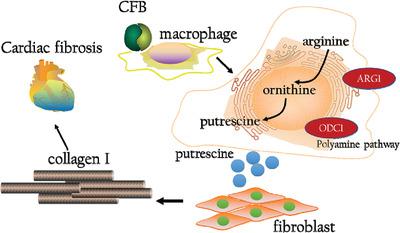当前位置:
X-MOL 学术
›
Eur. J. Immunol.
›
论文详情
Our official English website, www.x-mol.net, welcomes your feedback! (Note: you will need to create a separate account there.)
The role of the complement factor B-arginase-polyamine molecular axis in uremia-induced cardiac remodeling in mice.
European Journal of Immunology ( IF 5.4 ) Pub Date : 2019-11-27 , DOI: 10.1002/eji.201948227 Yang Yang 1 , Lu Ma 1 , Minghui Song 1 , Xiaomeng Li 2 , Fagui He 1 , Chao Wang 1 , Meihan Chen 3 , Jie Zhou 3 , Changlin Mei 3
European Journal of Immunology ( IF 5.4 ) Pub Date : 2019-11-27 , DOI: 10.1002/eji.201948227 Yang Yang 1 , Lu Ma 1 , Minghui Song 1 , Xiaomeng Li 2 , Fagui He 1 , Chao Wang 1 , Meihan Chen 3 , Jie Zhou 3 , Changlin Mei 3
Affiliation

|
The role of complement system in heart diseases is controversial. Besides, the mechanisms by which complement components participate in cardiac remodeling (CR) and heart failure during uremia are unclear. In this study, 5/6 nephrectomy was performed to adult mice to establish the uremic model and CR deteriorated over the course of uremia. Although complement pathways were not further activated over the course of the disease, soluble complement factor B (CFB) was upregulated at post-nephrectomy day 90 (PNx90) compared with PNx30. Further, CFB notably deteriorated CR in uremic mice but this effect was reversed by depletion of macrophages with liposomal clodronate. In vivo and in vitro CFB upregulated arginase 1 (ARG1) expression, increased ARG1 enzymatic activity, and stimulated the syntheses of ornithine, leading to polyamine overproduction in macrophages. Putrescine, an important polyamine, promoted cardiac fibroblast proliferation and collagen production, resulting in progressive CR. In vivo the inhibition of ARG1 activity with Nω -hydroxyl-l-arginine remarkably improved the general survival rates, inhibited the infiltration of cardiac fibroblasts, and alleviated progression of CR in uremic mice. Taken together, the CFB-ARG1-putrescine axis is related to progression of CR and ARG1 hyperactivity in macrophages may provide a novel therapeutic target against the heart injury in uremia.
中文翻译:

补体因子B-精氨酸酶-多胺分子轴在尿毒症诱导的小鼠心脏重塑中的作用。
补体系统在心脏病中的作用是有争议的。此外,在尿毒症期间补体成分参与心脏重塑(CR)和心力衰竭的机制尚不清楚。在这项研究中,对成年小鼠进行了5/6肾切除术以建立尿毒症模型,并且在尿毒症过程中CR恶化。尽管补体途径在疾病过程中并未进一步激活,但与PNx30相比,肾切除术后第90天(PNx90)可溶性补体因子B(CFB)上调。此外,CFB明显使尿毒症小鼠的CR恶化,但这种作用可通过脂质体氯膦酸盐消耗巨噬细胞而逆转。体内和体外CFB上调精氨酸酶1(ARG1)的表达,增加ARG1的酶促活性,并刺激鸟氨酸的合成,导致巨噬细胞中多胺的过量生产。腐胺是一种重要的多胺,可促进心脏成纤维细胞增殖和胶原蛋白生成,从而导致进行性CR。在体内,用Nω-羟基-1-精氨酸抑制ARG1活性可显着提高总生存率,抑制心脏成纤维细胞的浸润,并减轻尿毒症小鼠的CR进展。综上所述,CFB-ARG1-putrescine轴与巨噬细胞中CR和ARG1过度活跃的进展有关,可能为抵抗尿毒症中的心脏损伤提供新的治疗靶点。抑制了心脏成纤维细胞的浸润,并减轻了尿毒症小鼠的CR进展。综上所述,CFB-ARG1-putrescine轴与巨噬细胞中CR和ARG1过度活跃的进展有关,可能为抵抗尿毒症中的心脏损伤提供新的治疗靶点。抑制了心脏成纤维细胞的浸润,并减轻了尿毒症小鼠的CR进展。综上所述,CFB-ARG1-putrescine轴与巨噬细胞中CR和ARG1过度活跃的进展有关,可能为抵抗尿毒症中的心脏损伤提供新的治疗靶点。
更新日期:2019-12-11
中文翻译:

补体因子B-精氨酸酶-多胺分子轴在尿毒症诱导的小鼠心脏重塑中的作用。
补体系统在心脏病中的作用是有争议的。此外,在尿毒症期间补体成分参与心脏重塑(CR)和心力衰竭的机制尚不清楚。在这项研究中,对成年小鼠进行了5/6肾切除术以建立尿毒症模型,并且在尿毒症过程中CR恶化。尽管补体途径在疾病过程中并未进一步激活,但与PNx30相比,肾切除术后第90天(PNx90)可溶性补体因子B(CFB)上调。此外,CFB明显使尿毒症小鼠的CR恶化,但这种作用可通过脂质体氯膦酸盐消耗巨噬细胞而逆转。体内和体外CFB上调精氨酸酶1(ARG1)的表达,增加ARG1的酶促活性,并刺激鸟氨酸的合成,导致巨噬细胞中多胺的过量生产。腐胺是一种重要的多胺,可促进心脏成纤维细胞增殖和胶原蛋白生成,从而导致进行性CR。在体内,用Nω-羟基-1-精氨酸抑制ARG1活性可显着提高总生存率,抑制心脏成纤维细胞的浸润,并减轻尿毒症小鼠的CR进展。综上所述,CFB-ARG1-putrescine轴与巨噬细胞中CR和ARG1过度活跃的进展有关,可能为抵抗尿毒症中的心脏损伤提供新的治疗靶点。抑制了心脏成纤维细胞的浸润,并减轻了尿毒症小鼠的CR进展。综上所述,CFB-ARG1-putrescine轴与巨噬细胞中CR和ARG1过度活跃的进展有关,可能为抵抗尿毒症中的心脏损伤提供新的治疗靶点。抑制了心脏成纤维细胞的浸润,并减轻了尿毒症小鼠的CR进展。综上所述,CFB-ARG1-putrescine轴与巨噬细胞中CR和ARG1过度活跃的进展有关,可能为抵抗尿毒症中的心脏损伤提供新的治疗靶点。



























 京公网安备 11010802027423号
京公网安备 11010802027423号